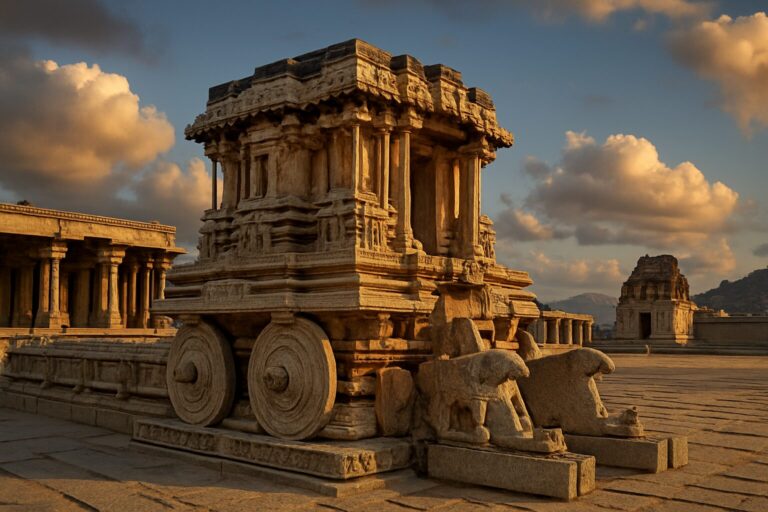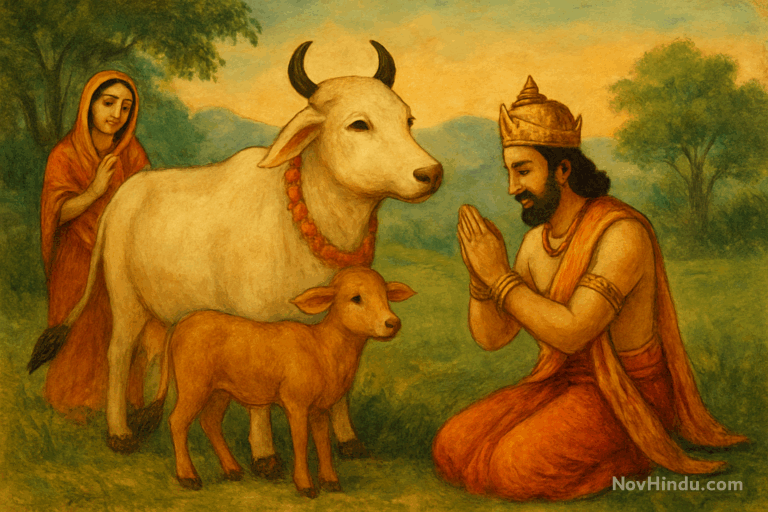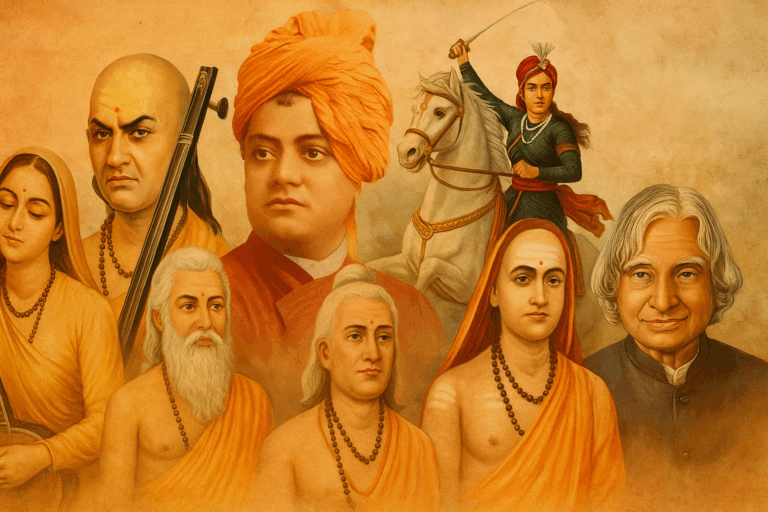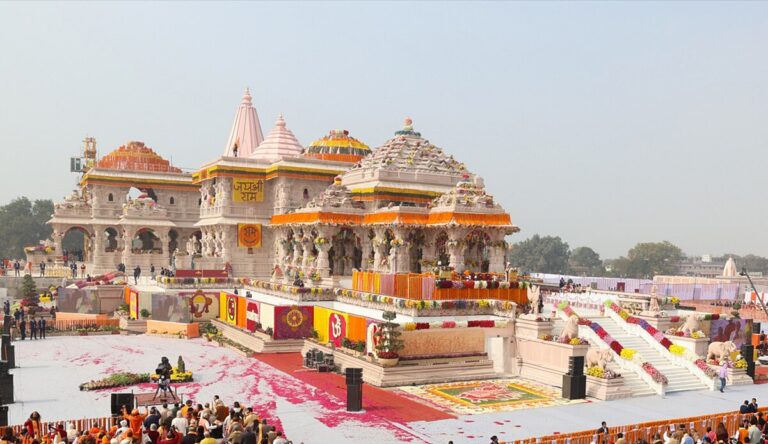The evening sky over Har Ki Pauri in Haridwar was painted in shades of orange and gold. Incense drifted gently through the air, mingling with the faint chill from the river. The rhythmic clang of temple bells and chants of “Har Har Gange!” wrapped the crowd in devotion.
Near the steps, an elderly sadhu sat cross-legged, his gaze fixed on the flowing water. A pilgrim, kneeling nearby, asked softly,
“Baba… the Ganga is eternal, isn’t she?”
The sadhu didn’t answer right away. He kept looking at the water, as if it held a secret. Then he said, almost in a whisper:
“Child, our scriptures say — when the weight of sin becomes unbearable, when mankind forgets its dharma, the Ganga will vanish from this world.”
The pilgrim felt a shiver. This was not just an old man’s tale. It was a prophecy… and perhaps, a warning.
The Ganga — More Than a River
In India, the Ganga is not just water flowing through a channel — she is Ganga Maa, the mother, the purifier, the life-giver. In the Rigveda, she is praised as Tripathaga, the one who flows in three realms — heaven, earth, and the underworld. The Mahabharata calls her “the purest of the pure” and describes her as the daughter of the Himalayas, descending to earth to wash away the sins of humanity.
Her waters have witnessed the coronations of kings, the penance of sages, the final rites of millions. From the icy mouth at Gaumukh in Uttarakhand to the vast delta in Bengal, she has nourished farmlands, quenched thirst, and carried the prayers of generations.
And yet, there is an ancient whisper in Hindu tradition — that she will not flow forever.
The Prophecy
Several Puranas, including the Bhavishya Purana and Skanda Purana, make veiled references to a time in Kali Yuga — the current age of moral decline — when the Ganga will retreat from the earthly plane. The exact words vary in different texts, but the essence is chilling:
“When greed, violence, and unrighteousness rise beyond measure… when humanity desecrates the very source of its life, the holy river will disappear, taking with her the blessings of the gods.”
Saints in different centuries have echoed this warning. In Varanasi, an old saying goes, “Ganga chalegi to sansar chalega. Ganga rukegi to sansar rukega” — “If the Ganga flows, the world will flow. If she stops, the world will stop.”
For centuries, these warnings were taken as symbolic — a call to live righteously. But now, science seems to be catching up with scripture.
Science Meets Scripture
The prophecy speaks of spiritual decline; science speaks of environmental decline. Both point in the same direction.
The Ganga begins at the Gangotri glacier, high in the Himalayas. In recent decades, this glacier has been shrinking at an alarming rate — some studies say it has already lost more than 25% of its mass. Climate change, deforestation, and human encroachment are accelerating its retreat.
Pollution adds another layer of danger. According to the Central Pollution Control Board of India, large stretches of the river are unfit for direct human consumption. Industrial waste, untreated sewage, and plastic clog her once-pristine waters. At many ghats, the same water used for ritual bathing is contaminated with dangerous bacteria.
It’s almost as if the prophecy is unfolding — not through divine magic, but through human negligence.
Voices from the Riverbanks
In Kanpur, a boatman named Ramesh recalls his childhood:
“When I was a boy, the water here was so clear you could see the fish. We would drink it straight from our cupped hands. Now… I wouldn’t dare. Even the fish are fewer.”
In a village near Allahabad (Prayagraj), farmers speak of unpredictable floods and summers when the river’s flow is too weak to irrigate their fields.
“It feels like she is angry,” one farmer says. “We pray, but maybe our prayers are too late.”
In Kolkata, an elderly woman comes every morning to offer flowers into the river at Dakshineswar.
“I know she is in pain,” she says quietly. “But she is our mother. A mother doesn’t abandon her children easily.”
Why the Ganga’s Disappearance Would Change Everything
Spiritually, the Ganga is believed to carry the power to wash away sins. Pilgrimage centers like Haridwar, Varanasi, and Prayagraj draw millions who believe that a single dip can purify the soul. Without her, a vast part of Hindu ritual life would be transformed — perhaps even lost.
Economically, the river supports over 400 million people. Farmers, fishermen, boatmen, and entire towns depend on her flow. If she were to dry up or become unusable, the displacement and hardship would be beyond imagination.
Ecologically, the Ganga basin is home to countless species — from the endangered Ganges river dolphin to hundreds of migratory birds. The collapse of her ecosystem would ripple across the subcontinent.
The Spiritual Lens
From a dharmic perspective, the Ganga’s state is a mirror to our collective karma. The prophecy warns not because destiny is fixed, but because it can be changed. In Hindu thought, divine beings withdraw when their sanctity is repeatedly violated — not as punishment, but as the natural result of imbalance.
Saints often remind devotees: the Ganga’s water is not just H₂O. It is teerth jal — sacred essence. To poison it is to poison the relationship between humanity and the divine.
The Scientific Lens
From a purely environmental standpoint, the “disappearance” of the Ganga could happen in more than one way:
- The source glacier melting away completely.
- Flow reduced to a trickle in summer months.
- Pollution making the river unusable for human and animal life.
Any of these outcomes would make the prophecy, in a practical sense, come true.
Bridging the Two Worlds
What’s remarkable is how the prophecy and the science seem to speak in harmony. One uses the language of sin and dharma, the other the language of carbon emissions and water tables — but both warn that the Ganga’s blessings are not unconditional.
It’s as if the sages of old were telling us: “Live in balance with her, or she will leave.”
A Moment of Choice
Back at Har Ki Pauri, the sadhu who whispered the prophecy watches the lamps float away into the night.
“Will she really vanish?” a young man asks him.
The sadhu smiles faintly.
“That depends on you,” he says. “A mother leaves only when her children no longer care for her.”
Perhaps that is the heart of the prophecy — not an unchangeable doom, but a warning we can still heed.
Whether you see the Ganga as a goddess, a river, or both — her survival is intertwined with our own.
Discover more from Nav Hindu
Subscribe to get the latest posts sent to your email.







